If I tell you that Atherosclerosis can be the start for brain and heart problems that lead to half of deaths worldwide, you wouldn't believe me. The bad news is that... unfortunately, it is the truth.
Now that I caught your attention, let's focus the spotlight on this disease.
Athero... what?
Atherosclerosis: from greek, Athero (gruel, sebaceous) & sclerosis (stiff, hardened).
It is a type of arteriosclerosis, a disease of blood vessels in which the vessels get harder for different reasons. In the case of atherosclerosis, occurs because of accumulation of fat on the vessel wall.
In a nutshell, there is hardening and accumulation of the wall that slowly occludes the vessel, leading to less blood flow and less O2 delivery, causing then damage in the tissues. However, it is a bit more complicated than that. So let's start a review on how it starts from the Pathology point of view!

Yes, all of that that is not hollow is atherosclerosis in the poor vessel :(
Risk Factors & Pathophysiology
The Risk factors for Atherosclerosis are the following:
- Arterial Hypertension (HTN)
- Hyperlipidemia
- Uncontrolled Diabetes Mellitus (DM)
- Cigarette Smoking
We will explain why in a second.
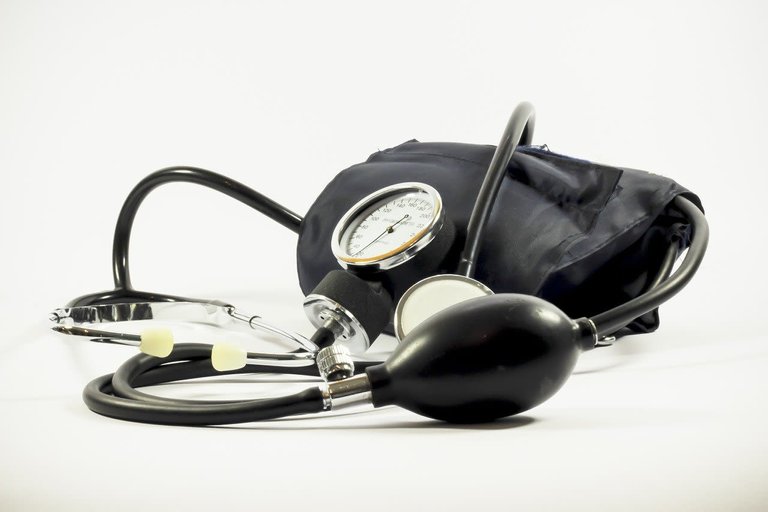
It all starts with damage of the epithelial cells present in the vessels: the endothelium. The damage can come from arterial hypertension (higher blood pressure). The "cut-off" value oscillates around 140/90 according to textbooks. with higher values increasing the risk even 5-fold! As there is a lot of pressure in the vessels, there is damage of the endothelium. From there, endothelium can be damaged enough to not produce Vasodilating substances like Nitric Oxide (NO) to decrease the HTN.
Unfortunately, 90% of arterial hypertension cases are primary, meaning we don't know a cause. The rest 10% can be from Heart problem, from Renal artery stenosis, etc.

Smoking is also an important factor in the pathogenesis. The reason is simple, a lot of chemicals in the cigarettes cross the lung membranes and reach to blood. From there, they can cause damage to any organ and, in this case, the vessels. The chemicals can vary from tars to ROS.
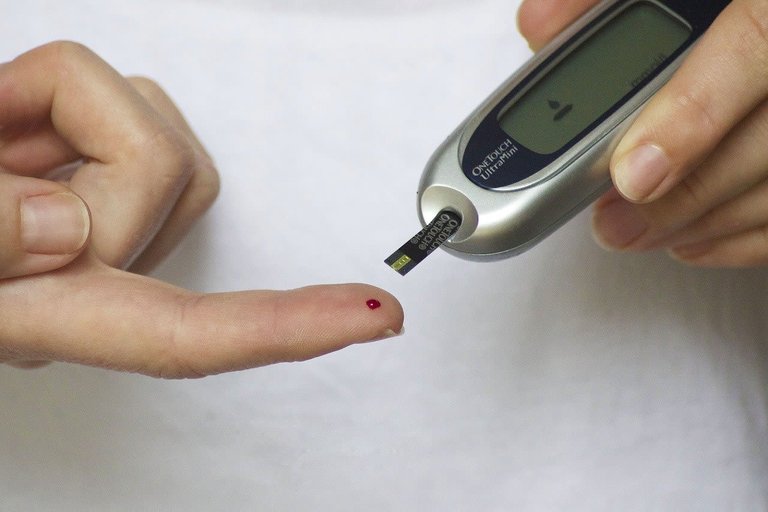
Another factor causing damage to the endothelium is hyperglycemia (in uncontrolled Diabetes Mellitus for example). The reason in this case is formation of Advanced Glycation End-products (AGE), which can damage any structure. Although the main one again are vessels.
These are sugars, which have a reducing power, that bind nonenzymatically to proteins in the body. The key part is nonenzymatically, because it takes a really long time to happen. However, if the hyperglycemia lasts for long enough, it can easily occur over time.
That is why, in Diabetes Mellitus patients, you can measure the levels of Hemoglobin A1c (HbA1c), which is the hemoglobin molecule with a glucose attached nonenzymatically to check if the patient had a long term hyperglycemia (and prevent the complications of that).
On the other hand, there is expression of AGE Receptor (RAGE) that binds to the AGEs. This causes an intracellular cascade leading to activation of NF-kB + cAMP (cytokine & second messenger). All this stimulate an inflammatory response with production of ROS & also activation of Monocytes from the immune system to perpetuate the inflammatory reaction.
Then, the activation of the polyol pathway of glucose happens too. This leads to reduction of glucose to sorbitol & finally oxidized to fructose. Problem here is that fructose and metabolites glycate "even harder" & the reduction and oxidation cause production of NADP and NADH respectively, leading to decreased glutathione and decreased protection against oxidative stress!

Finally, we will start with with the process formation of the atherosclerotic plaque. You first need hypercholesterolemia, which is defined as a high amount (hyper-) of cholesterol (-cholesterol-) in blood (-emia). Important is though the amount of "bad cholesterol" or LDL that you have. Laboratory values that we check on clinics for a healthy individual are the following (blood):
- Total Cholesterol levels: < 5 mmol/L
- LDL: < 3 mmol/L
- HDL: > 1.6 mmol/L

You could see it on the patient as xanthomas or xanthelasma, which are skin lesions that are full of macrophages eating cholesterol (lipo-phages).
Increasing the amount of HDL in blood & having a healthy diet is KEY!
Pathogenesis
After understanding the previous risk factors, atherosclerosic lesions are really straigth forward. As there is an inflammatory process already formed with activation of Macrophages & damage of the endothelium, it becomes very easy for LDL cholesterol to sneak in like a spy inside the inner part of the vessels.

With this inflammatory reaction, Macrophages start to express scavenger receptors like SR-A I, SR-A II. This leads to formation of oxidized-LDL inside the cells that cannot be easily removed. This can continue like a domino effect, causing more inflammation & more LDL reaching with more Macrophages moving into the walls of the artery, perpetuating the cycle.
All of this inflammtory process also causes the "recruitment" of fibroblasts and smooth muscle cells (SMC) to move to the site of the atherosclerosis, forming a plaque that is smooth in the vessel. Think of it as the body trying to cover it up inside.
Literature suggests that 70% occlusion starts to cause clinical symptoms!
Complications
The complications can be many, and symptoms depend on the arteries affected. The most common arteries affected are:
- Abdominal aorta
- Renal Arteries
- Common Iliac arteries
- Carotid arteries (toward the brain)
- Coronary arteries (around the Heart)
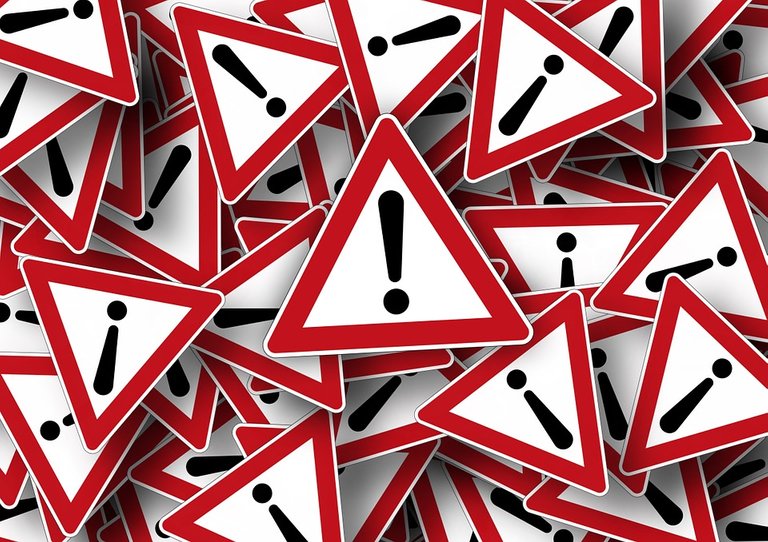
First, the plaque can obstruct causing a decrease or even stop in the blood flow, causing all type of ischemic damage as the tissues are not perfused.
Furthermore, the plaque can rupture and continue through the circulation (embolise) to cause all types of blockages in smaller vessels. Accompanied to this, the surface of the dislodged plaque is very thrombogenic, meaning that it can cause a lot of clot formation inside the vessels, and that can either form a cascade of clots all over the body, or clot arteries making an organ fail.
If it happens in the renal arteries you could develop HTN because of the sensing mechanism of the Kidney for Blood pressure.
On the carotids you will suffer a stroke.
On the coronaries you will have myocardial infarction
...
It is a nightmare!

As prevention, you can first start increasing your HDL by changing your diet and starting to have healthier habits like going for a jog or do exercise regularly. That way, you preserve the quality of your vessels and also can induce the formation of collateral vessels by endothelial cells producing Vascular Endothelial Growth Factor (VEGF) and many other factors.
Controlling HTN & Diabetes Mellitus is also important in this preventive process. Stopping smoking is also important, obviously.
Treatment
Treatment can be relatively simple, although really really invasive.
The method is called Stent implantation or Ballon angioplasty.
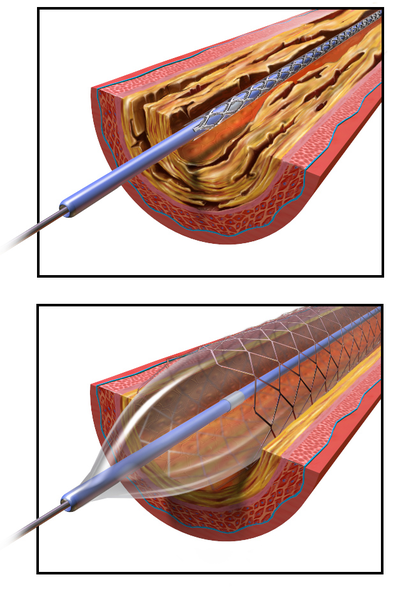
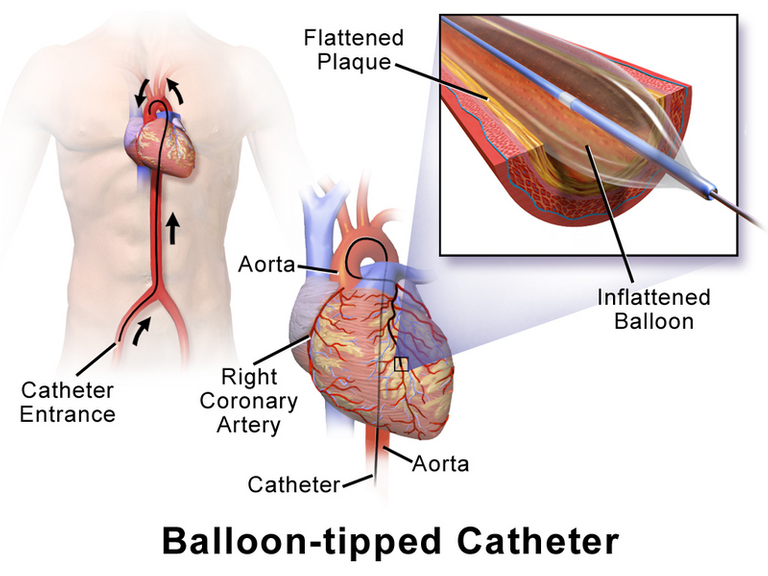
It is a really interesting method because first, you have to put a catheter inside the patient's artery, like for example in the radial artery.
After that, you work your way up towards the place of atherosclerotic plaque and there you inflate a balloon with a metallic stent outside that keeps the vessel expanded, so it is not occluded. The way you do it is by performing a coronary angiogram, basically a real-time X-ray with contrast, to see the vessels.
You can see one here by NEJMvideo on Youtube. Should look something like this:
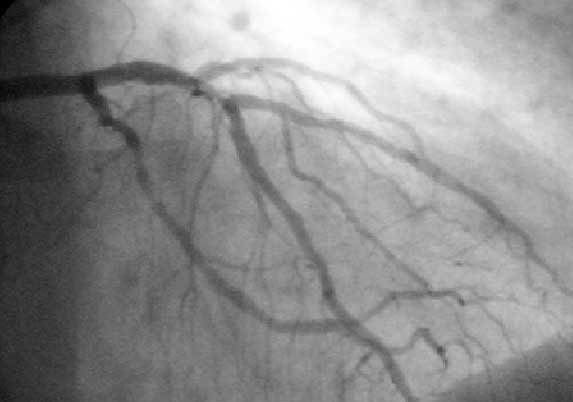
You can see the vessels in black with contrast and how it dimmens towards periphery, meaning that there is occlusion!
Closing
I am glad to be able to write again! I finally got the time (and patience) to do it. Hopefully I can continue writing more Medicine topics if Medschool continues to go smoothly!
Anyway, this is @deholt,
Signing off!
References
- Robbins Basic Pathology (10th Edition) - by Vinay Kumar Abul Abbas Jon Aster
- "Athero-" meaning by WordReference.com
- Arteriosclerosis - Wikipedia
- Atherosclerosis: Process, Indicators, Risk Factors and New Hopes - by Mahmoud Rafieian-Kopaei, Mahbubeh Setorki, Monir Doudi, Azar Baradaran, and Hamid Nasri at PubMed
- Atherosclerosis - by Aldons J. Lusis at PubMed
- Smoking and your heart - at PubMed
- Mechanism of Development of Atherosclerosis and Cardiovascular Disease in Diabetes Mellitus - by Naoto Katakami at PubMed
- Scavenger Receptors in Atherosclerosis - by Kathryn J. Moore and Mason W. Freeman at AhaJournals.org
- Angioplasty and stent placement - at MedlinePlus.gov
Images (in order):
- Atherosclerosis - by Nephron at WikiMedia Commons for Wikipedia (CC BY-SA 3.0)
- Blood Pressure cuff - by frolicsomepl at Pixabay
- Cigarette & smoke - by realworkhard at Pixabay
- Glucose measuring - by TesaPhotography at Pixabay
- Cholesterol - by stevepb at Pixabay
- Xanthoma - by Min.neel at WikiMedia Commons for Wikipedia (CC BY-SA 3.0)
- Atherosclerosis - by BruneBlaus at WikiMedia Commons for Wikipedia (CC BY-SA 3.0)
- Exclamation signs! - by geralt at Pixabay
- Fruits - by silviarita at Pixabay
- Balloon with stent - by BruneBlaus at WikiMedia Commons for Wikipedia (CC BY-SA 4.0)
- Balloon Angioplasty - by BruneBlaus at WikiMedia Commons for Wikipedia (CC BY-SA 4.0)
- Angiography - by Bleiglass at WikiMedia Commons for Wikipedia (CC BY-SA 3.0)
EDIT: fixed images, as they didn't show up
Congratulations @deholt! You have completed the following achievement on the Steem blockchain and have been rewarded with new badge(s) :
You can view your badges on your Steem Board and compare to others on the Steem Ranking
If you no longer want to receive notifications, reply to this comment with the word
STOPTo support your work, I also upvoted your post!
Vote for @Steemitboard as a witness to get one more award and increased upvotes!
Hi, I'm riccc96, I read your article and I really liked it, I would like to treat it with the stem.curate trial but the images should be fixed, let me know if you need any help
Hi riccc96, I'm glad you liked it. I fixed the images already, it should work now. Nothing that cannot be solved. Thanks for offering your help!
No problem, if you want to join us you are welcome, in the commentary of stem.curate you can find the links to join our discord and curation trial 💪
Hello,
Your post has been manually curated by a @stem.curate curator.
We are dedicated to supporting great content, like yours on the STEMGeeks tribe.
Please join us on discord.
@tipu curate
Upvoted 👌 (Mana: 5/10 - need recharge?)
This post has been voted on by the SteemSTEM curation team
and voting trail. It is elligible for support from @curie and @minnowbooster.
If you appreciate the work we are doing, then consider supporting our witness @stem.witness. Additional witness support to the curie witness would be appreciated as well.
For additional information please join us on the SteemSTEM discord and to get to know the rest of the community!
Thanks for having used the steemstem.io app and included @steemstem in the list of beneficiaries of this post. This granted you a stronger support from SteemSTEM.